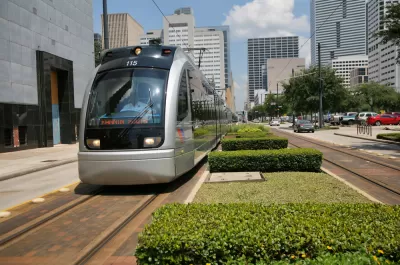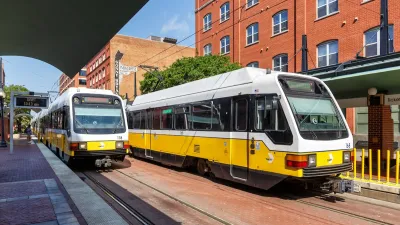Finally, the city seems to be reaping benefits from a major investment in public transportation.

Light rail has been an important (and expensive) part of urban development in both Dallas and Houston, two cities better known for sprawl than vibrant density.
In Houston, at least, two recent studies show that rail was a sound investment, notes Dian Nostikasari at Rice University’s The Urban Edge.
The first, from Texas Southern University, concluded, “[T[here have been measurable positive impacts from the development of light rail, at least on the Main Street corridor.”
The second, from one researcher with the Washington State Department of Transportation and another from the Texas A&M Transportation Institute, “examined changing land use within approximately half-mile of the rail stations along the original red, purple and green line in Houston.”
“That study found that along the original red line, there was a rise in commercial development that happened after the light rail came in but that began even before the red line was constructed. The study also found, increased development on vacant lands along these rail lines. This is a good thing as vacant land in cities like Houston tends to represent a lack of investment. Even as the Houston region continued to face a shortage of affordable housing supply, residential units along these rail lines increased – a trend across the country as living close to transit becomes a more attractive option.”
After many years of resistance to investing in public transit, light rail in Houston has been well received, as has the city’s investment in the bus system; together they represent a cultural and bureaucratic shift towards “walkable urbanism” in the city that doesn’t zone.
“Houston continues to grow but is at a crossroads post-Harvey,” Nostikarari writes. “Can it afford to continue growing as before and face the long-term consequences of being a car-dependent, outward growing metropolis? Or must it begin to think about prioritizing growing inward by improving its public transportation infrastructure and putting work places and other important destinations close to where people live while ensuring residents
FULL STORY: HOUSTON STUDIES SHOW LIGHT RAIL DID BRING SOME BENEFITS

Alabama: Trump Terminates Settlements for Black Communities Harmed By Raw Sewage
Trump deemed the landmark civil rights agreement “illegal DEI and environmental justice policy.”

Planetizen Federal Action Tracker
A weekly monitor of how Trump’s orders and actions are impacting planners and planning in America.

How Atlanta Built 7,000 Housing Units in 3 Years
The city’s comprehensive, neighborhood-focused housing strategy focuses on identifying properties and land that can be repurposed for housing and encouraging development in underserved neighborhoods.

In Both Crashes and Crime, Public Transportation is Far Safer than Driving
Contrary to popular assumptions, public transportation has far lower crash and crime rates than automobile travel. For safer communities, improve and encourage transit travel.

Report: Zoning Reforms Should Complement Nashville’s Ambitious Transit Plan
Without reform, restrictive zoning codes will limit the impact of the city’s planned transit expansion and could exclude some of the residents who depend on transit the most.

Judge Orders Release of Frozen IRA, IIJA Funding
The decision is a victory for environmental groups who charged that freezing funds for critical infrastructure and disaster response programs caused “real and irreparable harm” to communities.
Urban Design for Planners 1: Software Tools
This six-course series explores essential urban design concepts using open source software and equips planners with the tools they need to participate fully in the urban design process.
Planning for Universal Design
Learn the tools for implementing Universal Design in planning regulations.
Caltrans
Smith Gee Studio
Institute for Housing and Urban Development Studies (IHS)
City of Grandview
Harvard GSD Executive Education
Toledo-Lucas County Plan Commissions
Salt Lake City
NYU Wagner Graduate School of Public Service





























